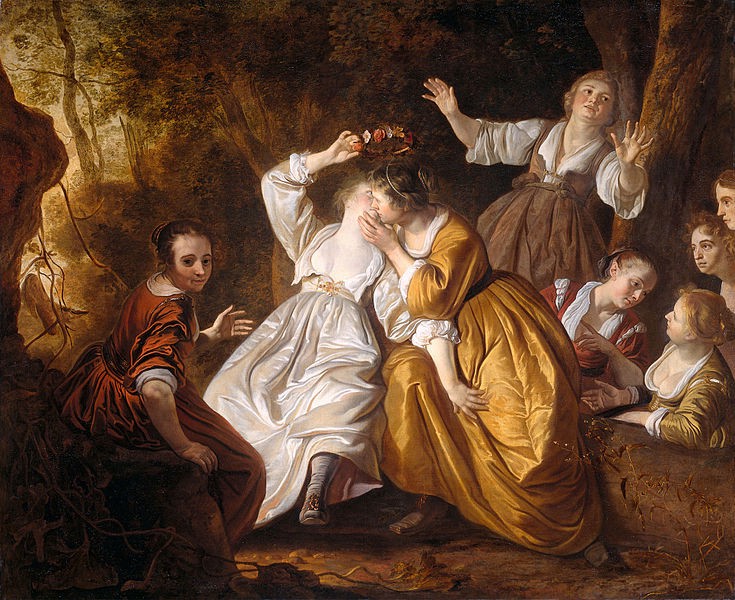When one thinks of women in the medieval world, images of quaint and quiet stereotypes usually pop into the mind. It was the thought of many that medieval women were subservient to their husbands or fathers, unable to live on their own and prosper. However, as time goes on and more is discovered about the medieval ages, more is being revealed about women who did not follow these stereotypes; women who lived alone, who entered into the army, who even took female lovers. The documentation of lesbian women is far less than that of gay men due to the fact that the patriarchal society often focused so much more on the lives and accomplishments of men. Also, lesbian sex was considered to be sodomy, the act of sex where no procreation can take place, so a lot of the historical documents about lesbians are negative. Although there is still much to be discovered about medieval lesbians, they are more present in history than many had ever thought before, especially in monasteries.
To understand the life of lesbian women in the medieval ages, it must first be understood that the definition of a lesbian was far less concrete in those days. Many scholars have agreed that there were two categories of lesbians within historical writings: sexual lesbians and “lesbian like.” Judith Bennett created the term “lesbian like,” which is used to describe those lesbians who may not have taken action on their attraction to women, but still existed. This definition allows for further exploration into the idea that medieval lesbians existed more than previously thought. Sexual lesbians were those who engaged in female sex, as well as other homosexual desires. Although lesbian is used as a blanket term in the modern times, using these two terms for the medieval point of view helps us to read further into readings that may have not been obvious at first.
Although it was often kept secret due to the biblical views on homosexuality, monasteries were common places for closeted lesbians to be. There is evidence of sexual lesbians having lived at a monastery. This evidence is a series of letters from one nun to another, who writes of love, as well as memories of sexual encounters. “When I remember the kissed you gave, and with what words of joy you caressed my little breasts, I want to die as I am not allowed to see you.” (Gwenners). There is also evidence of an unrequited love from a “lesbian like” nun named Hadewijch to another nun named Sara. Hadewijch writes a letter to the nuns at this convent, encouraging them to experience “earthly love” because only then will they truly understand a Godly love. (Matter, 85). Hadewijch writes “Greet Sara also in my behalf, whether I am anything to her or nothing. Could I be fully all that in my love I wish to be for her, I would gladly do so; and I shall do so fully, however she may treat me.” (Matter, 85). Hadewijch obviously has an immense love for Sara, yet Sara clearly has not returned this romantic love. Of course, homosexuality was viewed as a terrible sin according to the bible and the church, so it’s no wonder that there were not openly lesbian nuns around. There must have been many situations just like this in which one nun developed feelings for another and ended up in a one-sided attraction. However, due to homosexuality being viewed as a sin and the church often having an influence in laws at the time, lesbians could be punished for physical expressions homosexuality. Interestingly, lesbians were punished slightly less severely than gay men. A document describing the punishments for homosexuality lists the punishment for men to be four years of penance, while there is only a three-year penance for ““fornication” between women.” (Matter, 89). There is another case of sexual lesbians in the case of Benedetta Carlini, a nun who engaged in a sexual relationship with another nun for several years. Benedetta was brought to her abbey when she was only nine due to a promise made by her parents at her birth. Benedetta was literate and very bright. This caused her to become a very young abbess before she was thirty. Benedetta entered into a sexual relationship with another nun named Bartolomea Crivelli. Interestingly enough however, Benedetta imagined herself to be a male angel, even speaking in a deeper, more masculine tone, when she was engaged in sexual activity with Bartolomea. Judith Brown makes the interesting point that Benedetta may have been giving off this masculine persona in order to absolve herself and Bartolomea of sin. Although all sexual activity was off limits for Benedetta, it was less severe for the sin to be between a man and a woman. However, Benedetta may have taken it a step further with the thought that a male angel would be non-sinful. There are many interesting accounts of lesbian women throughout history, but the accounts of lesbian nuns are far rarer.
Lesbians were far more prevalent in history than previously thought, but the presence of lesbian nuns is something that many historians would not have thought to exist. However, as more historical sources are discovered and as more thought is put into the reading of these sources, more and more cases of homosexual nuns are being discovered. This brings much more meaning to documents in which nuns talk about their dear “friends.” Perhaps there is more to be understood in these documents than just platonic friendship. It is a very interesting subject that will, with any luck, be much more thoroughly explored by historians and other curious people alike.
Writing Details
- Lauren Iwanciwski
- 17 June 2022
- 940
- https://medium.com/illumination/what-life-was-like-for-lesbians-in-the-middle-ages-f80e17adf79e
- Tweet

Leave a Reply